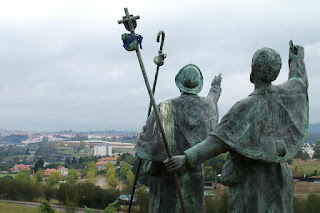Several weeks ago (just before school started - that got me busy again) I traveled with Cardinal O'Brien to Malta - a place with MUCH history - and great connections to Saint Paul (who, as the Acts of the Apostles recounts, was shipwrecked at Malta).
After a Friday afternoon flight (of just a little over an hour) we had Saturday morning free - so I took the opportunity to travel with Fr. Robert Monagle (who is my "boss" at Aviano and just happened to be there that weekend) to the Catacombs of St. Paul. We also visited St. Paul's Cave - where tradition says St. Paul lived and spent much time in prayer there in Malta - a spot that Pope Saint John Paul II visited as well on his apostolic visit to Malta years ago.
Much like the catacombs here in Rome, these were once used as burial places. But over the centuries they have been looted and "reclaimed" for other purposes.
The catacombs
What they look like above ground
There are ancient symbols and markings in the catacombs
Here, on May 27, 1990 Pope John Paul visited this spot and, the sign said, "spent much time in prayer."
The cave where St. Paul lived
I like this lamp - formed as a ship to remind us of Paul's shipwreck here in Malta.
Then, in the afternoon, the Investiture ceremonies began. Here are some photos from the day:
Cardinal O'Brien enters St. John's co-cathedral
On entering, we pause to pray before the Blessed Sacrament
Cardinal O'Brien delivers the homily
The Lieutenants who were present
The Knights and Dames of the Order in Malta
The servers did an excellent job - tho most said this was their first time. You'd never have guessed!
There is also a Caravaggio of the beheading of St. John the Baptist in the Co-Cathedral.




































































